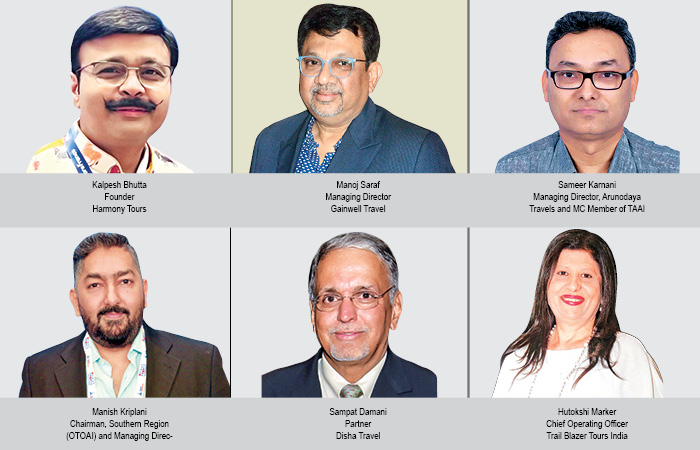The Chinese Embassy in India claims to have issued over 85,000 visas to Indian citizens between 1 January and 9 April 2025, promoting travel to China with relaxed visa rules and reduced fees. Despite this, the Chinese visa remains elusive for the Indian traveller. TRAVTALK asks tour operators about the challenges they are facing and their suggestions for other agents.
Hazel Jain
The Chinese Ambassador to India, Xu Feihong, recently announced on social media that 85,000 visas had been issued to ‘Indian friends’ between 1 January and 9 April 2025, as he invited more Indians to visit China and experience its “open, safe and friendly environment”. They have even extended the deadline for reduced visa fees until December 31, 2025 to encourage more arrivals. But agents in India continue to face hurdles. They claim that the Chinese embassy is rejecting 98 per cent visa applications without giving any reasons, and passports are being returned to applicants. They urge their fraternity to be careful and inform their clients accordingly.
NTO doesn’t exist for us!
Kalpesh Bhutta, Founder, Harmony Tours, says that while China is now open for tourists, visitor visas from India is a huge challenge. “Maybe their teams in India are not equipped to handle a large number of applications or they simply don’t want to issue visas to Indian travellers – it’s hard to tell. The truth is that the Chinese tourism board doesn’t exist for us, so the challenge of getting visitor visa can be solved by connecting with the NTO office based in Beijing with the help of key inbound operators from China who work with Indian tour operators,” says Bhutta.
Agents state that the root cause of the problem could be the geopolitical tension between the two countries. “What we understand as laymen that Chinese products have been roasted and, as a result, the Chinese authorities have reciprocated by scrutinising each and every visa application and granting limited visas for doing business,” Bhutta adds.
Manoj Saraf, Managing Director, Gainwell Travel, highlights discrepancies, and says, “In Kolkata, we are unable to obtain long-term multiple-entry Chinese visas, which are available in other jurisdictions. And, if a visa is denied, the Chinese Consulate does not issue a rejection letter. In Delhi, if a visa application is refused, reapplying immediately with the same set of documents often results in the visa being granted. Moreover, in Kolkata, applicants are required to submit their documents in person at VFS, as a live photo is taken during submission. In contrast, in other jurisdictions, agents are allowed to submit applications.”
A lottery system?
Sameer Karnani, Managing Director, Arunodaya Travels and MC Member of TAAI, also says that the Chinese consulate has become increasingly stringent and unpredictable in processing visas, with a surge in unexplained rejections. “A significant number of applications are denied due to alleged discrepancies in invitation letters, though applicants often assert the documents meet official requirements. This tightening appears to be linked to broader diplomatic friction between India and China, reflecting reciprocal tensions over visa policies. The process now resembles a lottery system, where reapplying might yield success through chance rather than procedural clarity. Authorities offer no explanations for rejections, leaving applicants in limbo,” says Karnani. This opacity, he adds, has created uncertainty for travellers with no guarantees even for meticulously prepared applications. The trend requires agents to adopt contingency plans. “They were always bad, but now they have gotten worse,” he says.
Manish Kriplani, Chairman, Southern Region (OTOAI) and Managing Director, Baywatch Travels, says, “Even when the same set of documents are attached for two applications, one gets approved and the other gets rejected. Sometimes we wonder if it’s the invite which is an issue or the company from where the invite has come. So, we ask our clients to try with another Chinese company for invitation which has resulted in success a few times! Go figure.”
Sampat Damani, Partner, Disha Travel, believes that the main challenge he faces when processing Chinese visas or any visa for their clients is ensuring that applicants understand the complexities of the visa issuance process. “In case of Chinese visa, the high rate of rejection is due to multiple reasons, primarily the mistrust between India and China in terms of business relations. Factors such as workload, time constraints and the sheer volume of applications can also impact the review process,” Damani suggests.
Hutokshi Marker, CEO, Trail Blazer Tours India, however, says that in her experience the submission process for Chinese visa has been smooth when applied with precise and accurate documents. “However, visa processing time has increased from 7 to 10 days, and we receive no explanations for rejections as it all appears in Chinese,” she adds.
 TravTalk India Online Magazine
TravTalk India Online Magazine







